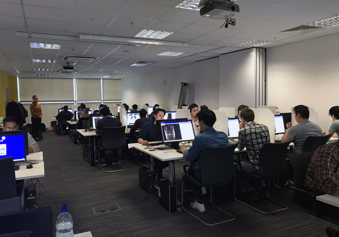DDMFR Part A - Anatomy Module - sample exam questions with ideal answers
LEARN MOREQuestion 1: Outline the boundaries, relations and contents of the masticator space:
Paired space of suprahyoid neck containing the muscles of mastication.
Relations:
anterior – buccal space
postero-medial – parapharyngeal space
posterior – parotid space
lateral – skin and adnexa
superior – skull base
Inferior-medial – submandibular space
Boundaries:
Enclosed by dividing sheet of superficial layer of deep cervical fascia producing a sling that encloses the space
fascial layer attached along lower border of mandible
lateral slip - passes up to zygomatic arch, then on over temporalis muscle up to temporal bone insertion
medial slip - passes up deep aspect of pterygoid muscles to base of skull (inserting medial to foramen ovale). Important is terms of spread of both infection and malignancy into middle
cranial fossa
Contents:
muscles of mastication (masseter, temporalis, medial and lateral pterygoid muscles)
V3 motor (muscles of mastication and mylohyoid nerve) and sensory branches (Inferior alveolar nerve, lingual nerve and auriculotemporal nerve)
Inferior alveolar vein and artery
facial artery and vein
mandible (ramus and posterior body of the mandible)
Question 2: Priya is a 48 year old female with a new onset hoarse voice. Clinical examination in the ENT department with flexible nasendoscopy shows that the left true vocal cord occupies a paramedian position and does not move during phonation. Describe the motor pathway of the left vocal cord:
The clinical features are of a vocal cord palsy. The motor supply of the true vocal cords is from the recurrent laryngeal nerve, which is a branch of the vagus nerve. The course of the left recurrent laryngeal nerve is not the same as that of the right recurrent laryngeal nerve. Vocal cord palsy can be due to interruption of impulses in the recurrent laryngeal nerve anywhere along its length, from intracranially to mediastinum.
The motor neurones of the vagus nerve are located in the brainstem (nucleus ambiguus) in the upper part of the medulla oblongata . Their axons coalesce when they leave the ventral surface of the brainstem with other axons from the dorsal nucleus of the vagus and the nucleus of the solitary tract and pass through the lateral cerebellomedullary cistern. The vagus enter the jugular fossa in the petrous temporal bone and then exits the skull base through the jugular foramen, where it lies between the glossopharyngeal and accessory nerves. The nerve runs
straight down the neck, within the carotid sheath, first within the retrostyloid compartment of the parapharyngeal space and then within the carotid sheath proper.
The vagus nerve enters the superior mediastinum with the carotid sheath and gives off the left recurrent laryngeal nerve, which hooks around the ligamentum arteriosum below the aortic arch in the aortopulomonary window to return back to the neck within the trachea-oesophageal groove. The nerve runs deep to the pre-tracheal fascia through the suspensory ligament of Berry to split into two branches at the level of the thyroid isthmus. It is usually the larger anterior
branch that is motor.
Our exams
Find out more about our FRCR exams in clinical radiology and clinical oncology, and DDMFR exams in dental and maxillofacial radiology.
